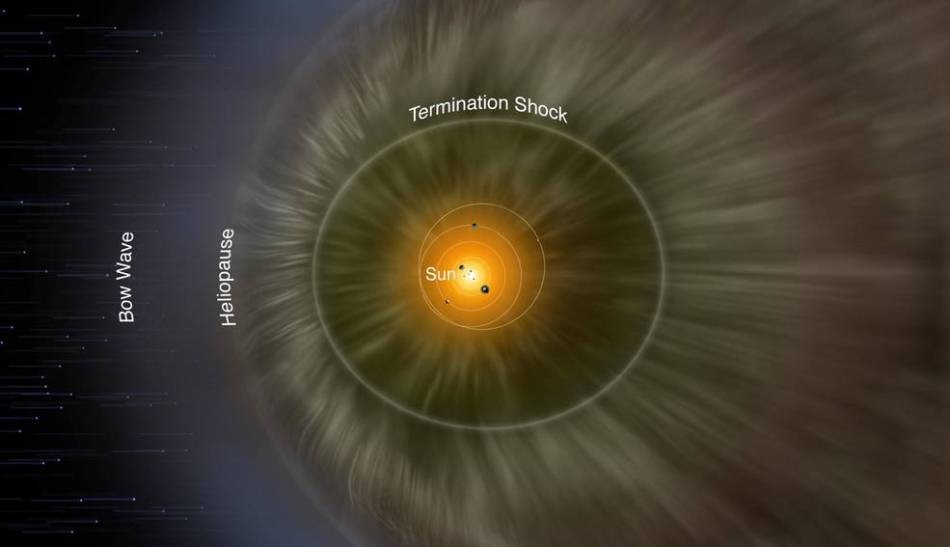Oct 10 2019
Higher pressure, observed at the boundary of the solar system, is the force exerted by magnetic fields, plasma, and particles such as cosmic rays, ions, and electrons on one another when they flow and collide.
 An illustration depicting the layers of the heliosphere. (Image credit: NASA/IBEX/Adler Planetarium)
An illustration depicting the layers of the heliosphere. (Image credit: NASA/IBEX/Adler Planetarium)
For the first time, scientists recently measured this pressure and discovered that it was greater than predicted.
Applying observations of galactic cosmic rays—a kind of extremely energetic particle—from NASA’s Voyager spacecraft, the researchers measured the total pressure from particles in the outer region of the solar system, called the heliosheath.
Located approximately 9 billion miles away, this region is not easy to explore. However, the peculiar positioning of the Voyager spacecraft and the favorable timing of a solar event rendered measurements of the heliosheath feasible. The results are now helping researchers comprehend how the Sun interacts with its environment.
In adding up the pieces known from previous studies, we found our new value is still larger than what’s been measured so far. It says that there are some other parts to the pressure that aren’t being considered right now that could contribute.
Jamie Rankin, Study Lead Author and Astronomer, Princeton University
On Earth, there is air pressure formed by air molecules pulled down by gravity. In space, there is also a pressure formed by particles such as electrons and ions. When heated and accelerated by the Sun, these particles form a giant balloon called the heliosphere, spreading millions of miles out past Pluto.
The boundary of this region, at which the Sun’s impact is overcome by the pressures of particles from other stars and interstellar space, is where the Sun’s magnetic effect ends. (Its gravitational effect extends considerably farther; therefore, the solar system itself spreads farther, as well.)
The researchers measured the pressure in the heliosheath by using the Voyager spacecraft that has been moving steadily out of the solar system since 1977. During the observations, while Voyager 1 was already outside the heliosphere in interstellar space, Voyager 2 was still within the heliosheath.
There was really unique timing for this event because we saw it right after Voyager 1 crossed into the local interstellar space. And while this is the first event that Voyager saw, there are more in the data that we can continue to look at to see how things in the heliosheath and interstellar space are changing over time.
Jamie Rankin, Study Lead Author and Astronomer, Princeton University
The researchers used an event called a global merged interaction region, formed due to the activity on the Sun. The Sun regularly flares up and discharges huge bursts of particles such as in coronal mass ejections. When a string of these events moves out into space, they can combine into a giant front, forming a wave of plasma pushed by magnetic fields.
Voyager 2 detected one such wave that reached the heliosheath in 2012. The wave induced a temporary decrease in the number of galactic cosmic rays. Four months later, the researchers observed a comparable decrease in observations from Voyager 1, just across the edge of the solar system in interstellar space.
Being aware of the distance between the spacecraft permitted them to measure the pressure in the heliosheath, as well as the speed of sound. Sound travels at about 300 km/second in the heliosheath—a thousand times faster than it travels through air.
The researchers observed that the variation in galactic cosmic rays was not precisely identical at both spacecraft. At Voyager 2, within the heliosheath, the number of cosmic rays reduced in all directions around the spacecraft.
However at Voyager 1, beyond the solar system, only the galactic cosmic rays that were moving perpendicular to the magnetic field in the region reduced. This asymmetry indicates that something occurs as the wave passes across the edge of the solar system.
Trying to understand why the change in the cosmic rays is different inside and outside of the heliosheath remains an open question.
Jamie Rankin, Study Lead Author and Astronomer, Princeton University
Analyzing the pressure and sound speeds in this region at the edge of the solar system can help researchers comprehend how the Sun impacts interstellar space. This provides researchers information about the solar system, as well as information related to the dynamics surrounding other stars and planetary systems.